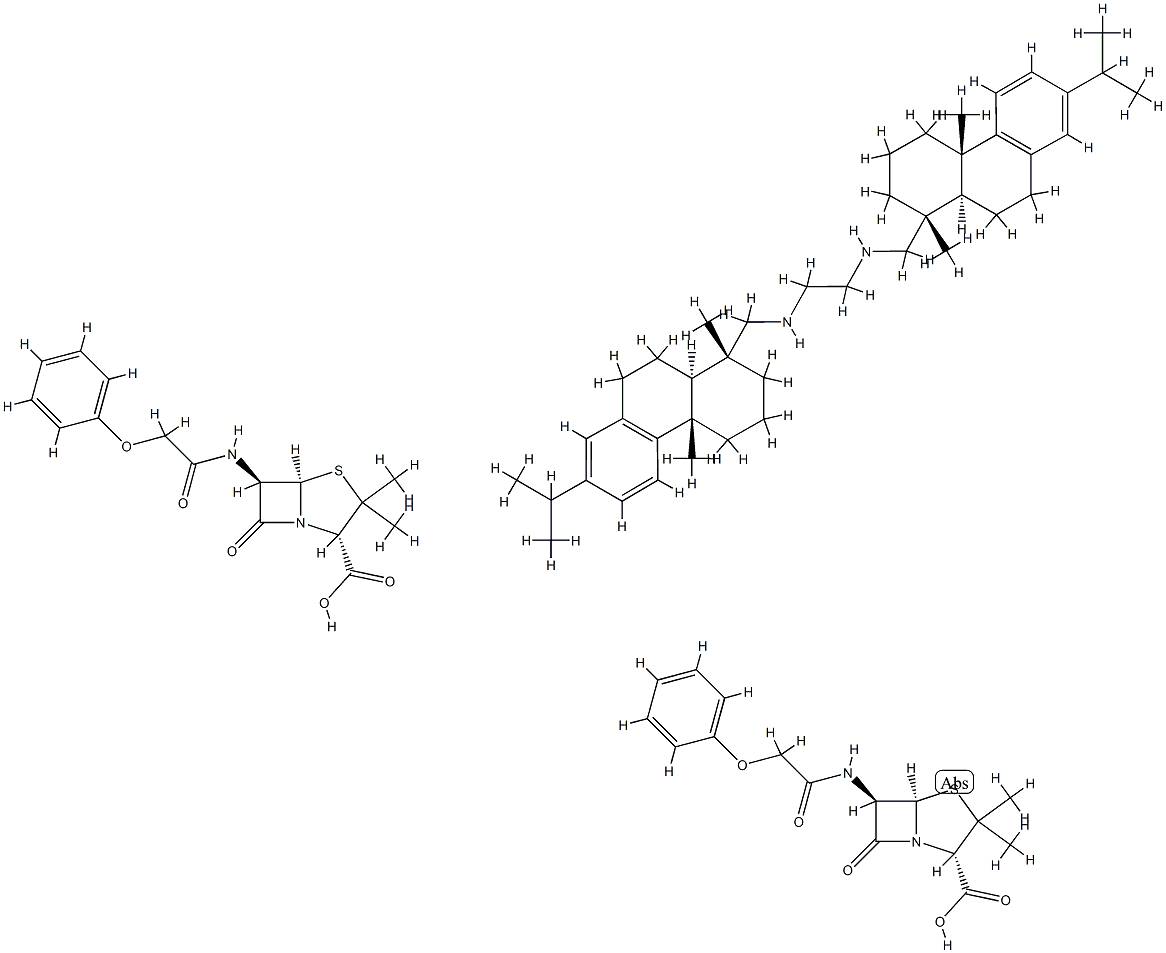|
|
| | penicillin V hydrabamine Basic information |
| Product Name: | penicillin V hydrabamine | | Synonyms: | penicillin V hydrabamine;N,N'-bis[[(1R,4~{a}S,10~{a}R)-1,4~{a}-dimethyl-7-propan-2-yl-2,3,4,9,10,10~{a}-hexahydrophenanthren-1-yl]methyl]ethane-1,2-diamine | | CAS: | 6591-72-6 | | MF: | C74H100N6O10S2 | | MW: | 1297.75 | | EINECS: | | | Product Categories: | | | Mol File: | 6591-72-6.mol |  |
| | penicillin V hydrabamine Chemical Properties |
| | penicillin V hydrabamine Usage And Synthesis |
| Originator | Compocillin-V ,Abbott ,US ,1954 | | Uses | Antibacterial. | | Manufacturing Process | The crude dihydrochlorides of dehydroabietylethylenediamine bases (985 g) are extracted with a solution of about 3 liters of chloroform and 3 liters of water which is adjusted to about pH 10 and a second extraction is performed using a solution of about 2 liters of chloroform and the mixture readjusted to about pH 10 with 6 N NaOH if necessary. The chloroform layer containing the mixed free bases is separated from the aqueous layer containing NaCl and is washed with about 1/10 its volume of water to remove any NaCl in the wet chloroform solution. The chloroform solution containing a mixture of the free bases having a volume of about 5 liters is dried with anhydrous Na2SO4 and then filtered to obtain a clear solution containing about 0.85 kg of the mixedfree bases.
Approximately 1,000 g of phenoxymethylpenicillin acid (Penicillin V) is dissolved directly in about 5 liters of ethyl acetate to a concentration of 20% w/v. The resulting solution is filtered to remove any insoluble salts. The penicillin V acid (1,000 g) may also be obtained by extracting an aqueous solution of 1,110 g of the potassium salt of phenoxymethylpenicillin at a temperature of about 5°C, this solution being adjusted to pH 2-3 by the addition of 6 N sulfuric acid, twice with a total of 5 liters of ethyl acetate so that the final washed combined volume will have a concentration of about 20% w/v. The abovementioned ethyl acetate solution having a volume of about 5 liters is then dried with anhydrous Na2SO4 and filtered to obtain a clear ethyl acetate solution of phenoxymethylpenicillin acid.
In place of the hydrochlorides of the above described bases any other acid salt thereof can be used, including both inorganic and organic salts such as phosphoric, sulfuric, and acetic acids. Also, in place of the mentioned penicillin, any of the other common salts of penicillin can be used as a source of penicillin acid.
The chloroform solution of the free bases prepared in the above manner is then slowly added to the ethyl acetate solution of the penicillin V acid prepared in the above manner. A clear solution forms which rapidly becomes turbid as the bases react with the penicillin acid and crystallization commences. The reaction mixture is allowed to stand overnight in a cool room having a temperature of about 5°C after thoroughly agitating the mixture. Thereafter, the crystalline N,N'-bis-(dehydroabietyl)-ethylenediaminedipenicillin V is filtered to separate therefrom the cooled mother liquor which contains the unprecipitated N,N'-bis-(dihydroabietyl)-ethylenediaminedipenicillin salt and N,N'-bis-(tetrahydroabietyl)-ethylenediamine-dipenicillin salt and other impurities. The precipitate is washed thoroughly with about 4 liters of a mixture of chloroform and ethyl acetate (1:1) which is divided into three separate portions. After the final washing, the crystals are substantially colorless. The crystalline penicillin salt is thoroughly dried under vacuum at a temperature of about 50°C. The N,N'-bis-(dehydroabietyl)-ethylenediaminedipenicillin V salt is obtained having purity as determined by solubility analysis in excess of about 90% and melts with decomposition at 163°C to 165°C on a Kofler hot stage. | | Brand name | Name previously used:
Penicillin Hydrabamine Phenoxymethyl. | | Therapeutic Function | Antibacterial |
| | penicillin V hydrabamine Preparation Products And Raw materials |
|